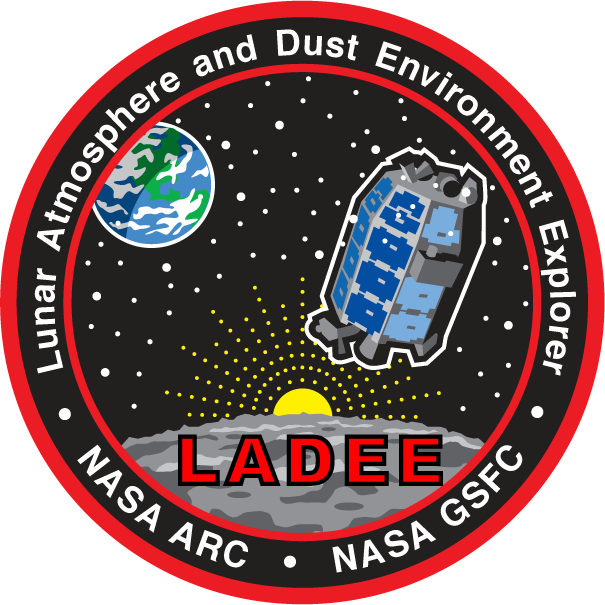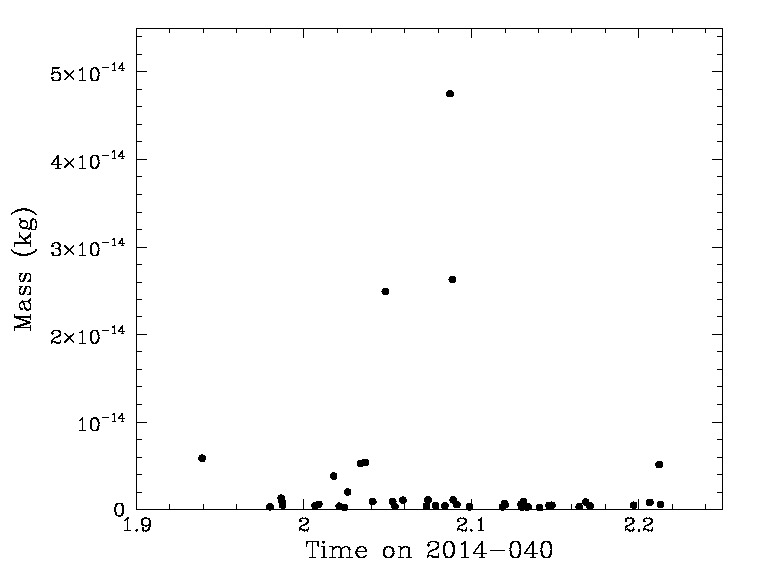
The Lunar Dust Experiment (LDEX) is an impact ionization dust detector. It measures the mass
of individual dust grains with m ≥ 1.7x10-16kg (radius, rs ≥ 0.3 μm) for impact speeds ≈ 1.7 km/s and also measures the collective current due to grains below the threshold for individual detection, enabling the search for dust grains with radius rg ≈ 0.1 μm over the terminators. LDEX is either ON or OFF - No other operational modes.
Useful Mission Documents
Mission Description
Spacecraft Description
Instrument and Data Description - Software Interface Specification (SIS)
Spacecraft Description
Instrument and Data Description - Software Interface Specification (SIS)
Archive Bundle Contents (Housed at the Small Bodies/Dust Node)
Document - Directory containing the document collection, which includes refereces to refereed
journals using this instrument, and information about calibration and explanation of data structures.
Housekeeping Data - Directory containing housekeeping data for the instrument.
Reduced Data - Directory containing processed data files.
Calibrated Data - Directory containing the calibrated data files. Calibration Documentation is in the SIS.
Derived Data – Directory containing derived values of dust density in the lunar atmosphere for grains with radii greater than 0.3 microns. The data consists of an ASCII table with dust density and errors tabulated as a function of altitude every 1.5 hours from 19:30 through 0:00 to 10:30 local time. See Horyani, M., Z. et al., The Lunar Dust Experiment (LDEX) onboard the Lunar Atmosphere and Dust Environment Explorer (LADEE) Mission, Space Science Reviews, 185 104), 93-113, doi:10.1007/s11214-014-0118-7, 2014.
Housekeeping Data - Directory containing housekeeping data for the instrument.
Reduced Data - Directory containing processed data files.
Calibrated Data - Directory containing the calibrated data files. Calibration Documentation is in the SIS.
Derived Data – Directory containing derived values of dust density in the lunar atmosphere for grains with radii greater than 0.3 microns. The data consists of an ASCII table with dust density and errors tabulated as a function of altitude every 1.5 hours from 19:30 through 0:00 to 10:30 local time. See Horyani, M., Z. et al., The Lunar Dust Experiment (LDEX) onboard the Lunar Atmosphere and Dust Environment Explorer (LADEE) Mission, Space Science Reviews, 185 104), 93-113, doi:10.1007/s11214-014-0118-7, 2014.
Other Useful Products for Interpreting the Data
Publications - A listing of team members to facilitate literature searches
Other Potentially Relevant Data
SPICE - Archived LADEE SPICE ancillary data providing observation geometry (positions, orientations, instrument pointing, time conversions, etc.) are available from the PDS NAIF Node
Other Potentially Relevant Data
Acceleration, Reconnection, Turbulence and Electrodynamics of the
Moon's Interaction with the Sun (ARTEMIS) (available soon from
PPI Node)
Lunar Elevation Map
Solar Activity
Meteoroid Environment
Moon's Interaction with the Sun (ARTEMIS) (available soon from
PPI Node)
Lunar Elevation Map
Solar Activity
Meteoroid Environment
SPICE - Archived LADEE SPICE ancillary data providing observation geometry (positions, orientations, instrument pointing, time conversions, etc.) are available from the PDS NAIF Node
For assistance in understanding PDS4 contact neese"at"psi"dot"edu at the Small Bodies Dust Node.
Citing the data for Publication
D. James, J. Szalay (2014), LADEE Lunar Dust Experiment, NASA Planetary Data System, https://doi.org/10.17189/1518954.


This is a plot of the mass of the impacting dust grains (in kg) vs. time (in hours) of impact. The data is a segment of the file mass_14040_14049.tab with the time plotted on the x-axis truncated from the UTC time in the file.
 PDS: The Planetary Atmospheres Node
PDS: The Planetary Atmospheres Node

